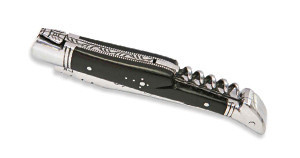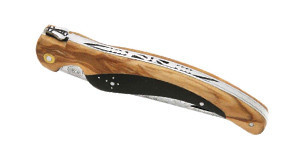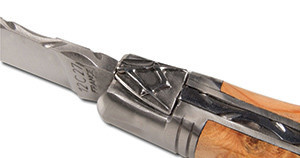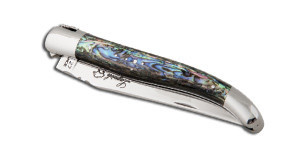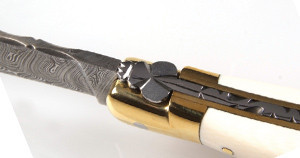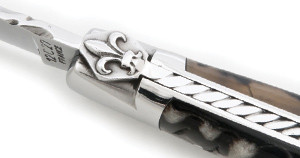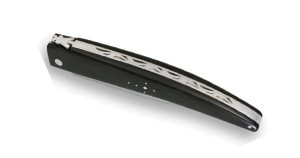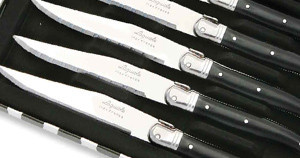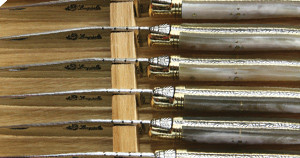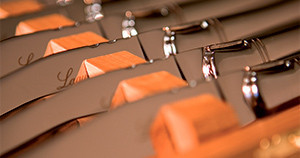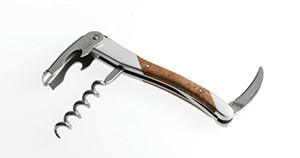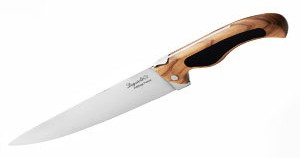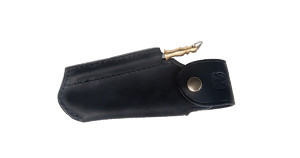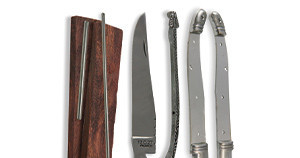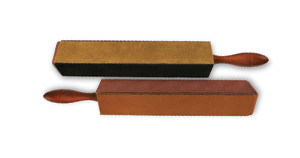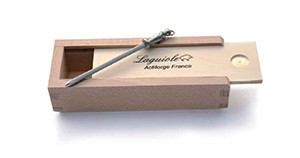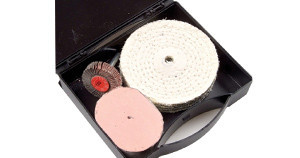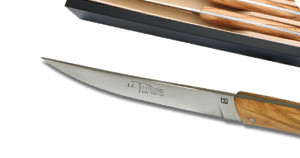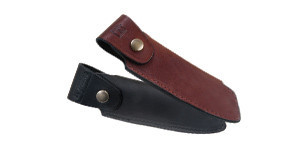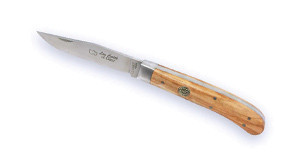
It is not enough to have beautiful Laguiole knives, we need knives with a perfect edge and a sharp blade, ready for use to relish the flavors of spring.
When the edge of your Laguiole dulls, you have trouble making nice slices of bread or meat, you then force on the blade to be able to have a good result, in vain.
If you plan to sharpen your blade yourself, be aware that you risk causing irreversible damage to your knife. Only an experienced bladesmith can sharpen a blade without putting your Laguiole at the slightest risk.
What is the method for sharpening a knife?
The Actiforge team is made up of skilled bladesmiths and will enlighten you on all the points you need to know to sharpen your knife yourself. It is very important that you apply these tips carefully in order to achieve the desired result.
Come on, no more waiting, here are the tips for sharpening your Laguiole knives this spring which promises to be festive.

Step 1 – Preparing your knife for sharpening.
Before understanding how to sharpen knives, you should know that the knives used to cut food must have two fundamental qualities: a good cutting edge and a blade without any imperfections or oxidation (rust). In order to carry out quality maintenance, it is therefore necessary to examine your knives starting with the cutting edge.
Did you know? It is easier to hurt yourself when working with a tool that does not cut and that requires you to make dangerous efforts. In any case, the cut with blades that are not sharpened is difficult and irregular.
Sharpening your knife therefore begins with thorough washing with soap and water, followed by complete drying.
.jpg)
Step 2 – The choice of material for sharpening a knife.
If you are an individual who loves quality knives, there are several tools at your disposal to sharpen your favorite knife:
-
A sharpening steel
-
A whetstone
-
Pocket sharpeners or mini sharpeners
-
Multi-sided sharpeners...
Depending on your budget or your dexterity, you will have to make a choice between these different objects. Today we are going to look at the use of the sharpening steel and the whetstone.
Step 3 - Sharpening knives with a sharpening steel.
OK, some of you may already know this method. This method is often used by those who like to have their paring knives sharp in the kitchen, it is practical, fast and non-invasive. In fact, this technique does not allow you to revive a knife that has lost its edge, but it does help you keep a minimally effective edge for cooking. This way, you can space out the time you need to sharpen with a whetstone, which is more abrasive to the metal of your blade.
The sharpening steel is quite cheap and very simple and intuitive. When a knife isn't cutting, it helps you realign the metal of the blade, filing away any nicks, scratches, and irregularities that are present.
Here's how to use a sharpening steel:
-
First, hold the knife in one hand, holding it at an angle with the tip pointing up. With the other hand, firmly grasp the knife so that you form an angle of about 20 degrees with it. It's okay if you're not precise, but you have to keep that same angle all the time if you want to smooth the blade evenly.
-
2. Now start rubbing the knife across the top of the sharpener, letting the blade slide towards the tip. The arm-wrist-hand movement must be ample and is essential for a perfect glide.
-
Repeat this step maintaining the same angle, this time using the lower part of the sharpener. Once the rotation is complete, you will have an (almost) like new knife.
Step 3 (Bis) -Sharpening knives with a whetstone.
To sharpen knives effectively, you must use a "wet stone" that gently removes the material and does not heat the metal.
This is a special sharpening stone that must first be soaked in water for 15 minutes.
Please note: some stones have two different grain surfaces, one with a lower numbering (coarser sharpening) and the other with a higher numbering (fine sharpening).
This method is the most demanding of the sharpening methods but offers an excellent result thanks to a stone, the whetstone or diamond sharpening stone.
Before using the sharpening stone, lubricate it with a little mineral oil specific to sharpening.
For the most common stones that are made of silicon carbide, they must be used with water. To do this, soak the silicon carbide stones for at least 15 minutes in cold water, keeping a bowl of water to moisten them if necessary, or lubricate the oil stones with mineral oil.
Here's how to use a whetstone:
-
Place the stone on a stable work surface, hold the knife at an angle between 17° and 20°.
-
Slide the blade of the knife over the stone, from the base to the tip, making a regular movement and exerting light pressure.
-
Sharpen each side of the knife in turn, making sure to always make the same number of passes on both sides.
-
repeat the movement several times per side, until you obtain the desired sharpness.
For best results, remember never to remove the blade from the stone until you have reached the tip of the knife. If you don't have a guide, keep in mind that the correct angle should allow you to lift the part of the blade without the cutting edge with the clearance needed to fit a thumb.
Also discover the video to help you sharpen your knife with a stone
Step 4 - Protecting the blade after sharpening.
The blade should always be protected from contact with other blades or metal objects. In the case of a folding knife, it is enough to store it closed or better slip it into a sheath. For fixed blade knives, you can use a set of blade guards to preserve your blades. These guards fit the full length of the blade. Another suitable way is to use a wooden block with notches in which you insert your blades.
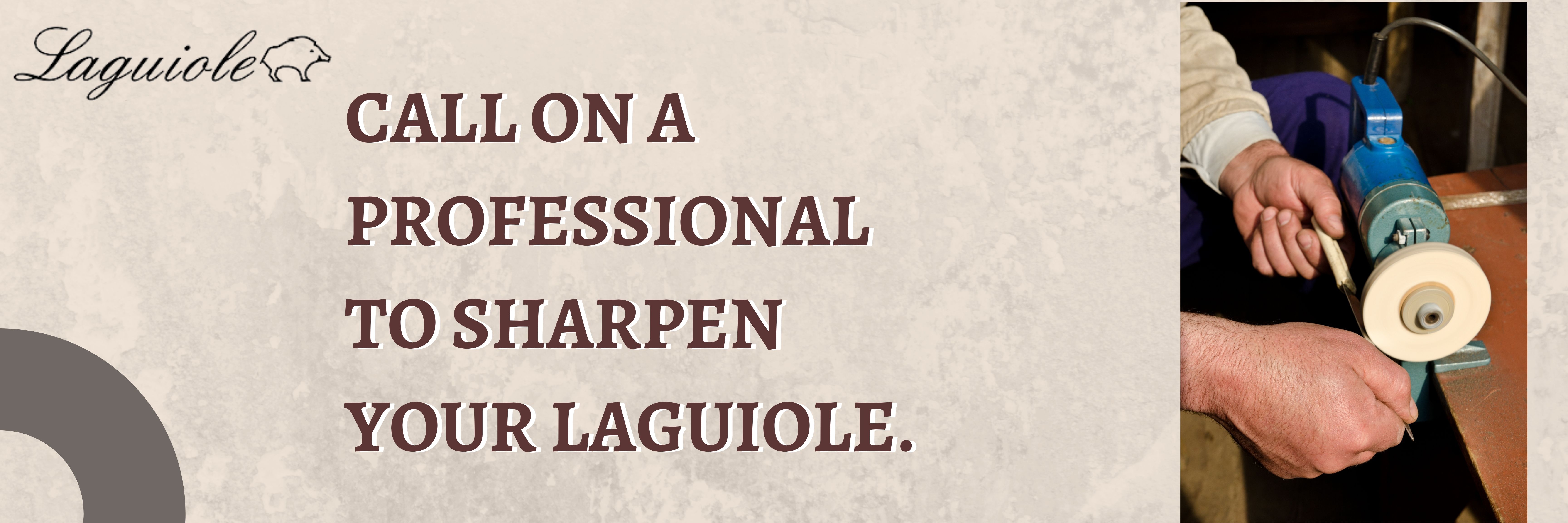
Call on a professional to sharpen your Laguiole.
When faced with a knife that doesn’t cut, if it's of a particular quality and value, it's a good idea to hire a professional bladesmiths to re-sharpen your blade.
You can contact us today to request the sharpening of your knife. Indeed, our bladesmiths are at your disposal to restore your knife to its original sharpness, without risk of accident during its sharpening!
We draw your attention to the fact that as simple as it may seem, sharpening is a practice that requires a certain knowledge to be carried out effectively and safely. In some cases, you can irreversibly damage your blade and lose all the benefit of the operation.
Don't take any risks: entrust your Laguiole to a professional for its maintenance – it will come back to you like new!
Information and conditions on simple call to 04 77 58 97 50 (Price of a local call) or by email via the contact form.



